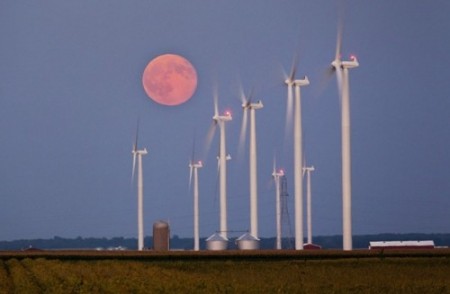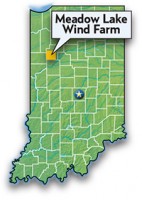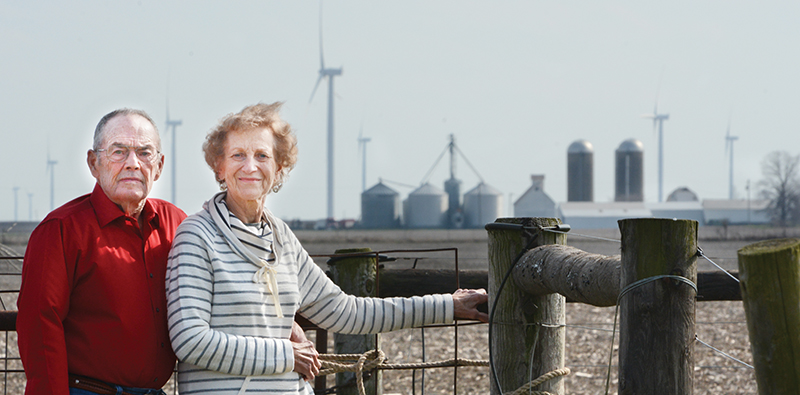
Dusk settles and a full moon rises over a farm in southwestern White County as giant turbines of the Meadow Lake Wind Farm harvest the power of the wind to create electricity. Meadow Lake is one of the largest wind farms in Indiana, and, beginning in 2018, Indiana’s electric cooperative power suppliers, Hoosier Energy and Wabash Valley Power Association, will be purchasing power from Meadow Lake for electric cooperatives to distribute to their member/consumers all across Indiana.
Photo by iStock.com/alexeys
For years, Jim and Gloria Humphreys would gaze out toward the towering tri-bladed turbines of the Meadow Lake Wind Farm south of their rural Wolcott home. The colossal pinwheels, clustered across the land for as far as their eyes could see, had them wondering two things:
• if they’d ever see the pair planned for their land actually built;
• and, why none of the electricity generated in the fields around them was used in Indiana.
The Humphreys, member/consumers of Carroll White REMC, need wonder no more.
 Last fall, EDP Renewables North America, the Houston-based company that owns and operates Meadow Lake, let it be known that new construction would begin in 2017. What’s more: The electricity generated with the addition will be purchased by Indiana’s electric cooperatives.
Last fall, EDP Renewables North America, the Houston-based company that owns and operates Meadow Lake, let it be known that new construction would begin in 2017. What’s more: The electricity generated with the addition will be purchased by Indiana’s electric cooperatives.
It’s the first mix of large-scale Indiana “home-blown” energy the state’s co-ops will be delivering to their rural and suburban consumers.
“We were in Phase III to begin with,” Gloria Humphreys said of their land. “Then, that was too big, so they made Phase IV. Well, then, that was still plenty big, so we got in Phase V.”
Meadow Lake is by far Indiana’s most visible wind farm and will now become its biggest. It’s the one motorists traveling Interstate 65 between Indianapolis and Chicago can’t miss; they pass diagonally through the heart of it.
Meadow Lake’s first four phases were built within the first two years of its development beginning in 2009; Phase IV began operation over five years ago in the autumn of 2010.
Despite the doldrums that seemed to set in since then, the Humphreys remained hopeful the next gust of growth would come. Landowners receive compensation for turbines placed on their property from the long-term lease and easement agreements.
Right now, Meadow Lake generates over 1.5 million megawatt-hours of electricity annually, EDPRNA reports. That’s enough to supply some 150,000 average homes with clean energy each year. Most of the power generated is sold in higher priced energy markets out of state.
“It’s always gone a long ways away,” Gloria said of Meadow Lake’s electricity. “We just wondered why they weren’t selling it here locally.”
Beginning Jan. 1, 2018, Indiana’s two co-operative power suppliers — Hoosier Energy and Wabash Valley Power Association — will purchase electricity from Meadow Lake’s 100 megawatt expansion. Hoosier Energy, serving REMCs/RECs in the southern half of Indiana, and Wabash Valley, serving the REMCs in the northern half, will be taking 25 MW each, initially. Then, in 2020, Hoosier Energy will begin purchasing 75 MW — which is 75 percent of the addition — from Meadow Lake.
“We’re excited about this opportunity to sell power to the Indiana REMCs,” said Brian Dunneback, development project manager with EDPRNA. “A lot of people find value that the power produced locally will be used locally. This is a special opportunity with Meadow Lake. It doesn’t happen too often.”
“We’re just following the lead of the consumers,” said Renewable Energy Manager Heath Norrick at Hoosier Energy. “The end consumers want to see a greening of the portfolio.” (Click here for a sidebar on Meadow Lake info at a glance.)
Winds of change
The Hoosier Energy/Wabash Valley partnership with Meadow Lake is just another example of how Indiana’s electric co-ops are diversifying their portfolios — the various ways the electricity they provide is generated (please see sidebar on next page).
“We’ve developed a balanced portfolio that isn’t beholden to one fuel type,” said Jay Bartlett, CEO of Wabash Valley. “It is an ‘all-of-the-above’ strategy that also includes energy efficiency programs to provide low-cost, reliable electricity to our members. Adding more wind generation to our portfolio is part of our journey to lower our impact on the environment.”
Wabash Valley’s ongoing effort to diversify its mix will bring its reliance on coal down to 45 percent by 2018; that’s the lowest percentage of coal used by any of the state’s larger utilities. The balance is made up of natural gas, alternative fuels, nuclear and other sources of energy.
“You’ll never do away with all the coal,” said Greg Wagoner, Wabash Valley’s vice president of transmission operations. “But, as we think about reducing carbon, our vision is to get a diversified portfolio. Wind is a huge energy source. And you take it when the wind blows, and you have to fill in when it doesn’t.”
Norrick, at Hoosier Energy, echoes the “all-of-the-above” choice. The trick, he said, is making intermittent renewables work better and more efficiently in concert with baseload resources, like natural gas and coal. “The whole utility industry is better at that now, but we still all have to acknowledge we have to have those baseload resources in order to meet our consumers’ needs,” he said.
Baseload resources are the ones that can be counted on 24/7 to meet energy demands and be dispatched as needed. Until the intermittency issues of wind and solar can be mitigated by advances in energy storage technology and lower cost for that technology, traditional, readily available fuels, like coal and natural gas, still will be needed to keep electricity affordable and reliable.
Still, wind power has seen tremendous growth and improvements over the past several years. And Indiana has been among the fastest growing states in the installation of wind capacity. As of last August, Indiana had about 1,760 MW of installed wind capacity, primarily from over 1,000 utility-scale turbines, reports Indiana’s Office of Energy Development.
While wind farms have drawn some opposition from local groups because of their high visual profile, the “whooshing” noise they make and potential harm to birds, many landowners have welcomed them for the economic benefits for themselves and their rural communities.
“Utility-scale wind farms can provide rural areas with significant investment and offer farmers new sources of revenue by opening their land to new energy development, while at the same time allowing present farming activities to continue virtually unchanged,” says the state energy development office.
Before 2008, Indiana had no commercial wind farms. The first came to Benton County on the Illinois line, after metering studies revealed surprisingly strong wind resources there. Also, Indiana has accessible existing transmission lines, the interstate of the nation’s electricity grid.
Now, there are six wind farms of over 100 MW. But because Indiana’s electricity, generated mostly from fossil fuels by its native load-serving utilities, has been relatively low cost, the independent wind farms sell their power mostly to out-of-state markets where electricity costs are higher.
“At the time they came, we were looking at other resources — trying to develop the portfolio with landfill gas, coal-bed methane and more recently solar,” noted Norrick.
Hoosier Energy and Wabash Valley separately pursued small amounts of wind power from farms in Iowa and Illinois when it was cost effective. The most recent was Hoosier’s 2014 agreement to purchase 25 MW from the Rail Splitter Wind Farm, another EDPRNA development, in central Illinois.
In the meantime, the federal Environmental Protection Agency moved forward with its Clean Power Plan to reduce the nation’s carbon dioxide emissions from fossil-fuel generation. The final version of the plan was released late last summer. Though the U.S. Supreme Court issued a stay on implementation of the rule until its many legal challenges could be decided in court, utilities are working to stay ahead of the changing times.
“Regardless of the status of the Clean Power Plan, we’re headed to a carbon-reduced environment,” said Wagoner. “So, anytime we can add ‘least-cost’ or ‘lowest-cost-as-possible’ resources, we’re going to continue to do that. Our objective is to look out long term.”
Hoosier Energy’s board of directors also looked long term. In 2014, it set a new goal for its portfolio to be 10 percent renewables by 2025. So, Hoosier Energy looked to Meadow Lake, and turned to its cooperative cousin, Wabash Valley, to split the purchase of the 100 MW. The deal was completed last fall.
“I can’t overemphasize how smoothly this process went,” said Norrick. “Anytime you bring multiple parties to the table, it can become very difficult, and the Hoosier Energy-Wabash partnership went so smoothly.”
Norrick and Wagoner point to the lower cost, driven by better technology, as the leading factor for making their move now to Indiana wind, as opposed to when the farms first came.
“There’s a 10-year gap between those developments,” said Norrick. “The technology improvements really are very significant.”
With taller towers, larger blades and better technology inside the turbines, Meadow Lake is experiencing capacity factors reaching 40 percent, up from the 30 percent capacity Indiana wind farms were predicted to average 10 years ago.
Wagoner noted the competitive deal, relatively speaking, also was because the power’s coming from an expansion, not an entirely new facility. “You’ve got an existing footprint. You’ve got the substation already built. Incrementally, you can add to it at a lower cost than the original project,” he explained.
In addition, Wagoner said the co-ops are seeing the advantages of continued tax incentives, lower equipment costs and increased efficiency and energy production. “Combine all those, and we’re seeing prices as much as 20-25 percent less today for wind than we did eight years ago.”
“We try to be very transparent about balancing the least cost with being more green,” said Norrick. “We’re trying to take a very steady, stair-stepped approach to that. But it’s still in the tune of hundreds of millions of dollars worth of expenditures over a certain time period in order to get that fleet more green.
“On the flip side, the 11 counties that produce coal in the state of Indiana are all within our service territory. So, we do balance that. These are important jobs. Our Merom coal-fired power plant is a very important resource to Hoosier Energy,” Norrick added. (Click here to see all the ways Indiana’s electric cooperatives generate electricity with alternative sources, or save energy.)
Into the wind
Wind development in Indiana’s northwest and elsewhere in its northern half still has much untapped potential.
EDPRNA is devoted to creation, innovation and sustainability. And Dunneback said the company is looking at the potential for future growth of Meadow Lake or at other locations.
Unlike any other mode of electricity generation, wind conjures up perhaps the most interesting sets of contrasts.
The energy is invisible, yet the towers to capture it are the tallest mechanical marvels on any rural landscape. Likewise, the fuel is free, but the towers and infrastructure require a huge investment and a patient return.
Wind can be elusive, but for miles and miles along the county roads, the wind farm is as accessible as the corn and beans its gleaming white towers grow up among. You can’t put a security fence around a wind farm like you can any other generating facility.
While wind is one of the earliest forms of energy humans put to work, integrating its fickleness with the digital, complex, 21st century electric grid has been challenging. As forecasting and technologies continue to improve, practical answers for cleaner energy will be found blowing in the wind.
And, wind farms require the co-operation and partnership with the local landowners and communities in a way most other sources of electricity do not. “It’s inherent that these projects do require a large footprint of land,” said Dunneback. “It’s very important to EDP Renewables to have a strong relationship with our partners — and we do consider the landowners our partners.”

Jim and Gloria Humphreys stand beside a fence on the south side of their yard in White County. Just beyond is their field that will host two wind turbines when Meadow Lake Wind Farm expands with its fifth phase south of Wolcott next year. The turbines in the distance are part of the existing wind farm that stretches to the southern, western and eastern horizons.
‘Home-blown’ energy
Wind blowing across the flat farmland has always been a part of life for Jim and Gloria Humphreys, life-long White County residents. And when Meadow Lake Wind Farm came along, they thought harvesting some of it was a good idea. “We’re always going to have wind,” Gloria said. “Jim’s dad used to say, ‘There’s nothing stopping the wind between here and Watseka [Illinois] — except the water tower.”
Once the new turbines of Meadow Lake are up and operational on their land, the Humphreys will be receiving a quarterly payment from EDPRNA for leasing the small footprint of land each tower will occupy.
And, as consumers of Carroll White REMC, still living in the all-electric ranch home they built 45 years ago where they raised their two daughters, the Humphreys will be getting an added benefit from Meadow Lake they hadn’t initially planned on.
Come 2018, when they gaze out over their field to their turbines along their property line, then glance at the lights of their barn or flick on the porch light, Gloria said she then might be thinking: “This power could be manufactured just right out in the back field.”
“It’ll be nice to have some of it right here,” she added.
Richard G. Biever is senior editor of Electric Consumer. To learn more about the Indiana’s wind energy, visit this Office of Energy Development site at in.gov/oed/2413.htm.



